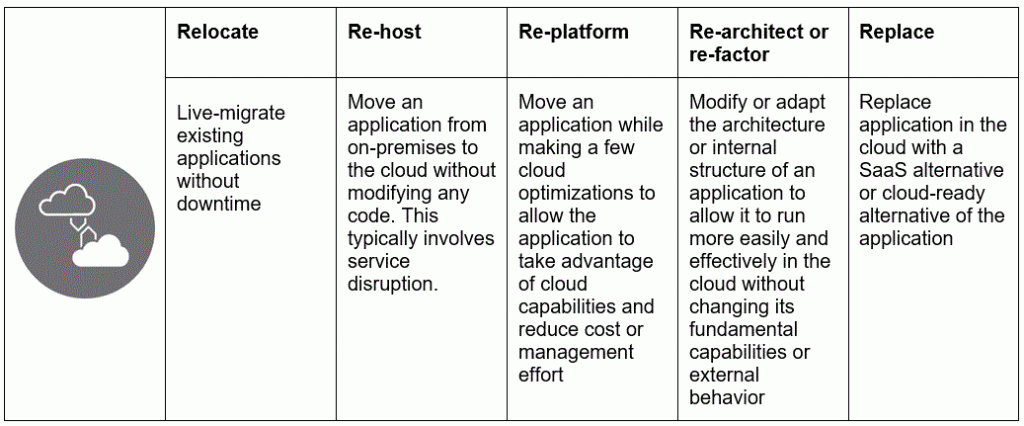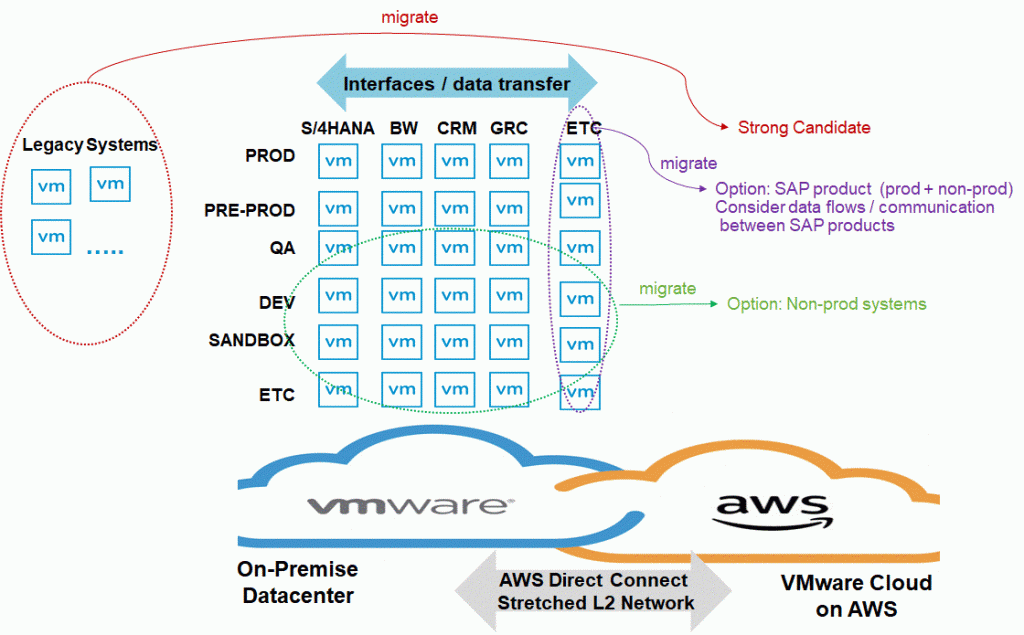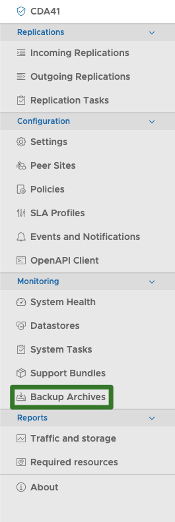VMware Cloud on AWS is not supported for SAP workloads at this time. Please stay tuned to https://twitter.com/vmwarecloudaws .
In previous articles we have demonstrated VMware Cloud on AWS functionality and use cases with SAP systems. In this article, we take a step back and at a high level describe the migration options for the SAP environment to VMware Cloud on AWS.
The SAP environment can be complex consisting of multiple products and solutions each comprising production and non-production systems (this is referred to as the SAP landscape). Enterprises running SAP landscapes on VMware on-premises today love the VMware ease of provisioning and its management capabilities. SAP customers are continuously innovating, which means they need more SAP systems to drive all this innovation. They are adding new SAP applications, adding new landscapes for various SLDC processes (Software Development Life Cycles: testing, performance testing, project development etc..). However, this transformation can present challenges. Enterprises don’t have unlimited datacenter capacity, power, cooling, space and that’s just for starters. Enterprises will need to procure servers to power their VMware clusters and perform all the setup, management and maintenance of these clusters. While some of these SAP landscapes are permanent others are time bound. VMware Cloud on AWS provides an excellent opportunity for customers to grow SAP landscapes to meet their business needs and address the challenges of transient computing demands. Customers can adopt a long-term migration strategy to cloud. VMware Cloud on AWS enables a hybrid cloud where the SAP landscape can be split between on-premise and cloud during a long-term phased migration approach.
One of the easiest and earliest type of systems to move to VMware Cloud on AWS are legacy / read-only SAP systems that may no longer be supported by SAP but are potentially important reference systems for the company. For example, many companies have requirements to retain the data held in their SAP systems for at least 7 years. Furthermore, for companies migrating to SAP S/4HANA who adopt a greenfield approach will need to manage their existing SAP ERP systems if they do not plan to migrate all the historical data across to the new S/4HANA environment. These legacy systems are an important part of SAP transformations but are overlooked or are an after-thought.
VMware considers different migration approaches which are described in the following table.

The relocate and re-host options are applicable to SAP systems that are virtualized on-premise on the vSphere platform. These two approaches involve either cold or live migration of SAP virtual machines to VMware Cloud on AWS. These migrations can be achieved via a VMware SaaS tool VMware HCX or long distance vMotion (for the latter see this blog). During migration to VMware Cloud on AWS there are no modifications to the SAP systems assuming they are running in VMware virtual machines (if the on-premise SAP systems are on physical then a physical-to-virtual conversion is required first). There may be a resizing of virtual machines which depends on the SAPS utilization on-premise and the SAPS rating of the target hosts on VMware Cloud on AWS.
The following diagram shows an example SAP landscape and highlights some migration options during a phased migration strategy.

The diagram highlights the following:
- SAP business solutions require multiple SAP products / modules which are shown horizontally above: S/4HANA; BW (Business Warehouse); etc. There is typically data transfer between these systems that are critical to the overall business process.
- Each SAP product consists of production and non-production systems. These are shown vertically in the diagram above.
- The intersection of an SAP product and production or non-production environment corresponds to a separate database and set of application server virtual machines.
- The legacy systems environment corresponds to older SAP systems (e.g. SAP R/3 or ECC) from which customers have upgraded from but are required to keep for compliance reasons.
A phased migration to VMware Cloud on AWS can include the following options:
- Legacy systems are a strong candidate to move first to VMware Cloud on AWS. These systems are read-only, do not change, their utilization is low and have minimal to no data communications to other systems in the production and non-production landscape. They can be moved to VMware Cloud on AWS without any changes to the Operating System or Database.
- Non-production systems can be migrated before production – these systems may not have the highest SLA compared to production and hence can be easier to migrate first from a people, process standpoint.
- An individual SAP product (production and non-production systems) can be moved before the other SAP products. In this case consider data communication between systems which would occur between cloud and on-premise.
Summary
The SAP landscape can comprise many systems from production, non-production to legacy environments. A phased migration strategy of SAP to VMware Cloud on AWS enables some of these systems to be migrated first resulting in the landscape being split between the cloud and on-premise. This hybrid cloud scenario can be easily achieved with VMware Cloud on AWS and helps to avoid data center expansion while cloud migration occurs over a long-term strategy.
This article has been co-authored by AWS and VMware: Somckit Khemmanivanh; Adam Hill; Vas Mitra; Sai Gopalan.






